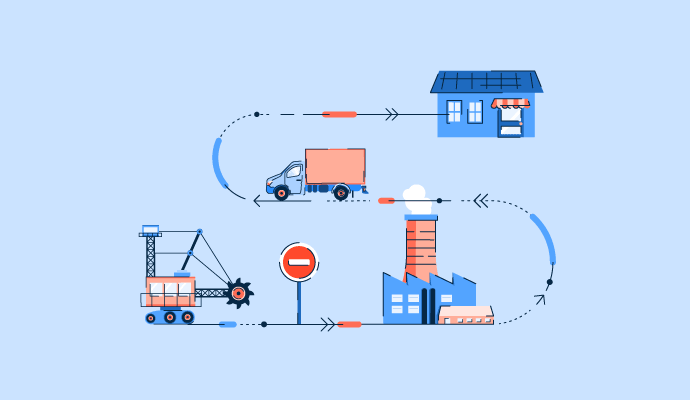What is supplier relationship management?
Supplier relationship management is the overall maintenance and management of working relationships between buyers and their vendors.
When working with different vendors, it’s important to maintain good supplier relationships to keep the flow of goods and materials consistent. Evaluating these relationships helps businesses develop more strategic relationships with suppliers that increase profits.
Most businesses have several suppliers at once and choose to manage their affairs in supplier relationship management software. These tools facilitate and support the business relationships with vendors that are essential for the continued operation of the organization.
Types of supplier relationship management
Businesses working with suppliers fall into one of two categories of supplier management, although in some cases, they could use both types for different departments. These types are:
- Vertical. In vertical supplier relationships, goods and raw materials move along the supply chain from manufacturer to supplier to distributors and retailers. Individual businesses at each part of this supplier chain are in frequent communication and work together often.
- Horizontal. Businesses may work with others in a mutually-beneficial situation. Each business probably specializes in one particular area that the other business doesn’t; both work together to cover more areas of their industry. For instance, a business making engine parts could work with a company that makes tires, with both collaborating to supply local mechanics.
Basic elements of supplier relationship management
No matter the industry, an effective supplier relationship management program must include at least three crucial steps.
- Supplier segmentation. Breaking suppliers into categories is useful for organizing vendors, particularly when assessing them and deciding on which ones to continue working with and which to replace. Vendors can be grouped in different ways, such as quantity of supplies, location, or pricing.
- Supplier strategy. Once suppliers have been segmented, companies can develop a strategy for the continuing relationship. Multiple strategies can be created based on the segment categories or overall needs of the business. The supplier relationship management software should contain all the details of the plans for easy reference in the future.
- Strategy execution. Finally, the strategy must be put into practice. Every relationship should be as valuable as possible, both for the buyer and the vendor. Monitoring performance using a supplier management dashboard is helpful, as businesses can track and measure key performance indicators (KPIs) to determine whether an ongoing relationship is worth pursuing.
Benefits of supplier relationship management
Having an effective supplier relationship management system in place is beneficial for many businesses in seeing greater revenue. The biggest benefits of this practice are:
- Saving money long term. Some vendors may have higher costs at the beginning of a partnership with a business. When companies continue to have good relationships with suppliers, prices may come down as the partnership becomes more mutually beneficial. Suppliers may also be more willing to find discounts to pass on to buyers they like.
- Increasing operational efficiency. Poor communication at any point during the supply chain is a logistical nightmare that becomes costly if products are delayed as a result. Supplier relationship management means the vendor and the buyer build trust, which often leads to fewer disruptions. If there are issues, communication is typically more established so these problems can be resolved more quickly.
- Improving product quality. Vendors, particularly in a vertical supply chain, may find out information about the changing quality of a raw material or finished product before the buyer or retailer. In this situation, they may look for an alternative supplier other than themselves to prevent the final retailer or buyer from having a below-standard product. This keeps continuity throughout the supply chain for both the final buyer and the customer.
Best practices for supplier relationship management
Poorly managed supplier relationships can hurt businesses. The best way to achieve long-term success and meet business goals is to follow several best practices, including:
- Setting strategic goals. Businesses gain valuable insights when measuring supplier relationships against company-set goals. Metrics like order accuracy or defective rate of supplies can help businesses see which vendors are better to work with than others.
- Using a centralized supplier management platform. Much like sales teams use a customer relationship management (CRM) system, buyers should centralize their supplier relationship information in a single platform. This makes vendor information accessible to anyone on the team who needs it while making any updates or additions easy to make and share.
- Creating a strong onboarding process. When working with a new vendor, gather baseline information that can be input into internal systems. Collect and store all legal, compliance, and risk documentation upfront, along with any other critical pieces of information for the business. Having a good onboarding process helps get the relationship off on the right foot and protects the vendor and supplier against future issues when key pieces of information are recorded.
- Using automated features. Many supplier relationship management programs have automated features that help businesses with onboarding and reporting without any work by the internal team. These features keep data more accurate and alert the team to any issues as they arise.
Keep the entire supply chain efficient and smooth with supply chain planning software.

Holly Landis
Holly Landis is a freelance writer for G2. She also specializes in being a digital marketing consultant, focusing in on-page SEO, copy, and content writing. She works with SMEs and creative businesses that want to be more intentional with their digital strategies and grow organically on channels they own. As a Brit now living in the USA, you'll usually find her drinking copious amounts of tea in her cherished Anne Boleyn mug while watching endless reruns of Parks and Rec.

